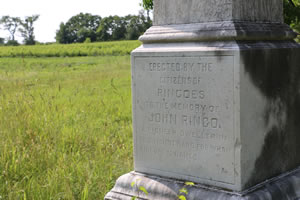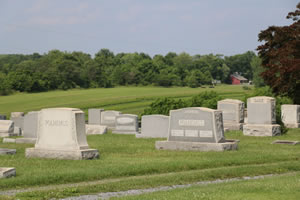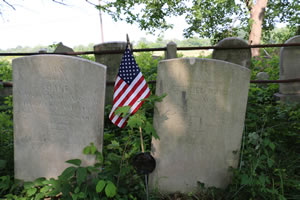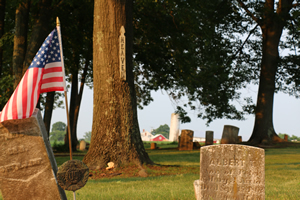If you plan on visiting these 5 fascinating cemeteries, we remind you to please be respectful to the deceased and their families when visiting these final resting places.
Ringos’ Family Burial Yard
Located on a hill just west of where the historic Ringo’s tavern once stood, the Ringos’ family burial yard was probably first used to bury Peter and Jane Cook Ringo, who died a week apart in December 1750. They were the third son and wife of Philip Ringo, a nephew of our community’s founder John Ringo, and the keeper of the soon-to-be-famous tavern. Although only three burial stones can be seen poking out of the ground, this yard contains the remains of a number of Ringo family members, including John Ringo (the second), who was quite active for the Americans during the Revolutionary War. The stone monument in the burial yard was erected in 1932, a gift from Flemington resident John Reardon to honor the town’s founder.
Union Cemetery
This cemetery, off Boss Road, was incorporated on October 25, 1876 by a group led by Dr. Cornelius Larison, Noah Blackwell and John Dalrymple. Several months earlier, Blackwell had purchased the 4.29 acres to establish the cemetery. Then, the grounds were laid out, the roads made, the trees planted, and a memorial monument erected in the cemetery’s center. The first interment here was a child named Peter Snyder, who died in 1877. The cemetery is the final resting place for Dr. Larison – the doctor, educator, founder of the Amwell Academy and proponent of phonetic spelling. Check out his tombstone and see if it’s spelled phonetically!
Servis-Quick Family Cemetery
This small family cemetery is perched atop a hill beside County Route 579 just past the Black River and Western Railroad tracks. The oldest recorded grave dates back to 1790 – William Servis Sr. – and the burial grounds were still being used in the early 1900s. The stone wall surrounding the cemetery was built in 1848, replacing a hemlock fence. While Hunterdon County records from 1918 list 56 graves on this tract, the researchers acknowledge that there are numerous unmarked graves on site.
Wertsville Baptist Church
Sandwiched between the Old School (Conservative) Baptist Church in Hopewell and a more liberal Baptist Church in Flemington, the Wearts Corner Baptist Church began in 1836 for congregants dissatisfied with either congregation. The church thrived throughout the 1800’s with Sunday Services, Sunday school, and Christian Endeavor. In 1859 they had 92 adult members and 80 children enrolled in Sunday school classes. Their first minister William Pollard preached three years and abruptly died and is buried in the graveyard. The Church was very strict, and would throw out members for “unchristian behavior” such as intoxication, dancing and playing cards. Members would have to appear before a committee where they would have to apologize for their sins in order to be readmitted. The Church lost membership in the last 1800’s, finally closing its doors with one final baptism in 1908. The Church records are housed in the Hunterdon County Historical Society. The Church building was turned into a chicken coop, an industrial garage and later converted to a residence in the 1990s.




Old Baptist Church Cemetery, Hopewell
John Hart may have spent a winter in the Sourland Mountains but he lived in Hopewell and gave land for the Old School Baptist Church even though he was a Presbyterian. We finish our tour with a visit to this cemetery and his monument – the first erected in New Jersey to commemorate any of her sons. You will see the famous stepping stone on which Colonel Joab Houghton, upon hearing of Lexington and Concord, stood and announced “Men of New Jersey, the Redcoats are murdering our Brethren in New England; who will follow me to Boston.” Also read the gravestones of men who fought in every war, including 18 Revolutionary War soldiers and 16 Civil War soldiers. Then try to find the cenotaph of Stephen Weart Blackwell who perished on the Titanic. We might even tell a ghost story or two of the happenings within the brick church, closed since 1973.

